Book Reviews 4
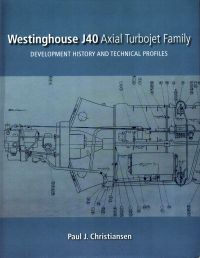 |
Westinghouse J40 Axial Turbojet Family
Development History and Technical Profiles
by Paul J. Christiansen
Softbound, 8.5" x 11.0" x 0.6", 274 pages
ISBN-13: 978-0692358528
Bleeg Publishing LLC (2015)
Recommended Retail Price: $47.95
125 pictures/diagrams, black and white |
Reviewed by Kimble D. McCutcheon - 22 Apr 2015
After WWII, the U.S. Navy identified a requirement for a 7,500 lbT-class turbojet, and requested proposals based on that requirement in 1947. The Westinghouse Advanced Gas Turbine Division (WAGT) proposed an engine whose performance appeared to better the engines proposed by Allison, Pratt & Whitney and Wright Aero; it also was to have the shortest development schedule and lowest program cost. The Navy awarded WAGT a contract on 30 June 1947.
WAGT had designed and built the ~1,500 lbT-class J30, which was first U.S. axial flow turbojet. WAGT then scaled up the J30, resulting in the ~3,000 lbT-class J34. Having successfully doubled the thrust once, WAGT reasoned it would be easy to do it again with the J40.
WAGT encountered trouble from the start with the intake, compressor, combustor, turbine, afterburner and engine control system. Weight grew, dimensions changed and components got moved about. WAGT had neither the in-depth engine cycle understanding nor the resources to address the challenges it faced. It had no in-house experimental machine shop, so it had to depend on vendors to supply and rework parts, causing contract overruns and schedule slips.
After the contract was awarded, world events led the Navy to change the J40 requirements over and over again. The acquisition of nuclear weapons by the U.S.S.R., along with the Korean War, led to the need for even more powerful engines, and resulted in the Navy contracting for a number of J40 variants.
The WAGT J40 program never produced viable engines, and the aircraft programs that depended on them suffered accordingly. The experience led Westinghouse to exit the aircraft engine market in 1965.
Christiansen describes the procurement, development, specifications and technical details of the J-40-1, -2, -4, -6, -8, -10, -12, -14, -16, -18, -20, -22, -24 and -26 in great detail, with 853 citations from more than 106 different sources, nearly all of which are primary. He charts the operating envelopes for various models and lists the component vendors. He also summarizes the U.S. House of Representative Government Operations Committee hearings that concentrated on McDonnell F3H aircraft that were grounded and undergoing rework or being scrapped because of J40 problems.
Christiansen’s book not only presents a detailed account of the J40, but also illuminates the huge challenges facing all engine manufacturers in those early days of jets.
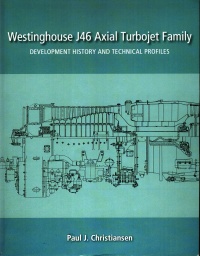 |
Westinghouse J46 Axial Turbojet Family
Development History and Technical Profiles
by Paul J. Christiansen
Softbound, 8.5" x 11.0" x 0.7", 286 pages
ISBN-13: 978-0-692764-556
Bleeg Publishing LLC (2016)
Recommended Retail Price: $47.95
77 illustrations, black and white |
Reviewed by Kimble D. McCutcheon - 26 Nov 2016
Paul Christiansen continues his excellent series on Westinghouse gas turbines in his latest book, which covers the J46 family. This is an in-depth account of how the Westinghouse Aviation Gas Turbine division attempted to bridge the gap between the U.S. Navy’s ever-changing requirements and the emerging technologies that might have met them.
The J46 was expected to have been a relatively straightforward development of the Westinghouse J34. However, the integration of an afterburner and all-new electronic control system, coupled with the Navy’s predilection for changing requirements and plans to use the J46 in a number of very different airframes, proved to be more than Westinghouse could accomplish within the aggressive schedule. Several aircraft projects that were to have used the J46 were cancelled and the Vought F7U-3, the only J46-powered aircraft to enter production, had a short service life, partially due to engine issues.
Christiansen begins with a review of the J34 program, which produced many developments and improvements that were central to the J46 program. He then describes elements of the J34-WE-22 and -38 that were to have been shared with the XJ46-WE-2 and ultimately covers procurement and development of the XJ46-WE-2 and -4. Three chapters cover XJ46 and J46-WE-8/A/B and -12/A/B development, production and service. Other chapters chronicle J46-WE-18 and XJ46-WE-1, -3, -5 and -7 development, J46 flight testing, and J46 improvement/growth programs. Christiansen’s Analysis and Conclusions chapter reiterates how the Navy’s indecision and focus on superfluous details added to the technical problems both the J46 and F7U-3 programs faced. Appendices provide engine ratings and specifications, operating limits, a (long) list of YJ46-WE-8A field service problems, and a list of surviving J46 examples.
With 925 citations from 204 sources (nearly all primary), this book, like its predecessor, provides valuable insight into early U.S. gas turbine development. Christiansen is hinting that a book on the early Westinghouse engines (19A, 19B, 9.5A, 9.5B, and 19XB2A, which became the J30) is in the works; this I shall anxiously await.
AEHS Members can get Westinghouse J46 Axial Turbojet Family at a 20% discount by using the discount code from the Members’ Bulletin Board. The book is also available from Barnes & Noble and Amazon.
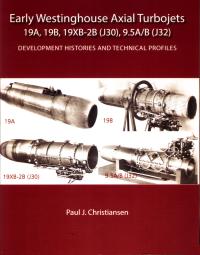 |
Early Westinghouse Axial Turbojets
19A, 19B, 19XB-2B (J30), 9.5A/B (J32)
by Paul J. Christiansen
Softbound, 8.5" x 11.0" x 0.875", 362 pages
ISBN-13: 978-1792061-493
Bleeg Publishing LLC (2019)
Recommended Retail Price: $42.95
191 illustrations, black and white |
Reviewed by Kimble D. McCutcheon - 29 Mar 2019
Westinghouse, with some of the best U.S. steam turbine and combustion scientists, was included from the start when the National Advisory Committee for Aeronautics’ (NACA) Special Committee on Jet Propulsion was formed in April 1941. The Committee also included representatives from the U.S. Navy Bureau of Aeronautics (BuAer) and U.S. Army Air Corps. Westinghouse was soon tasked to study jet engines for aircraft propulsion.
Motivated by the U.S. entry into WWII and working under a U.S. Navy development contract, Westinghouse rapidly studied various compressor, burner and turbine options, designed the experimental prototype Model 19A, built it and ran the first U.S. axial-flow turbojet on 19 March 1943. After addressing problems with main shaft bearings, oil seal leakage and combustion instability, the engine passed a 100-hr endurance test in July 1943. A second 19A was built, hung below a Vought F4U-1 and test flown as a booster engine in early 1944. Additional 19As were built and flown as booster engines in the tails of a Martin JM-1 (Navy B-26C) and a Douglas XBTD-2. In addition to in-house testing, the NACA and Navy also performed tests. Westinghouse delivered five complete 19As and one complete set of parts.
Westinghouse had no prior experience with aircraft engines or with the BuAer. This resulted in a steep learning curve, considerable friction and numerous delays as Westinghouse, BuAer and the various airframers dealt with development and production of the 19A and its descendants. Westinghouse also faced the same component, contractor, personnel, machine, manufacturing space and material shortages that plagued all other wartime manufacturers. BuAer finally had to insist upon and enforce standardization in procurement, security, documentation, engine configuration, production, field support, overhaul and reporting; Westinghouse never fully mastered all this.
Using lessons learned from the 19A, Westinghouse embarked on the 19B, with an refined compressor, simplified annular burner, improved turbine and increased performance. The 19B was intended as a primary power plant rather than the booster engine the 19A had been. This engine also had its own set of development and production challenges. Preliminary development flight testing was first done in the Martin JM-1, after which the 19B provided primary power for the McDonnell XPD-1 and Northrop XP-79B.
Westinghouse again used all lessons learned from the 19A and 19B to design the 19XB, which was meant to be the production version of the engine. Again, the compressor, burner and turbine were refined and performance enhanced. The Westinghouse Model 19XB-2B was given the J30-WE-20 turbojet engine designation and the J30-P-20 was built under license by Pratt & Whitney.
The Westinghouse Models 9.5A and 9.5B arose in late 1942 to fill a request for a small-diameter turbojet, several of which could be buried in the wings of a small fighter, thereby reducing nacelle weight and sharing accessories and systems, which would reduce complexity. When trade studies established the number of engines required would greatly increase cost, the engine came into consideration for missile propulsion as the J32. A total of 44 engines were produced.
Paul J. Christiansen has covered another Westinghouse saga with the depth and attention to detail we have come to expect. As with past ones, this work is based almost exclusively on primary sources. It is a must for anyone wishing to understand how early U.S. turbojet engines were developed and produced. The book is available from Amazon.com.
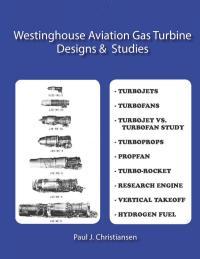 |
Westinghouse Aviation Gas Turbine Designs & Studies
by Paul J. Christiansen
Softbound, 8.5" x 11.0" x 0.25", 84 pages
ISBN-13: 978-1-702071-574
Bleeg Publishing LLC (2019)
Recommended Retail Price: $19.95
74 b/w illustrations
|
Reviewed by Tom Fey - 3 Dec 2019
Westinghouse Aviation Gas Turbine Designs & Studies by AEHS member, AEHS Convention presenter, and author Paul J. Christiansen is an 84-page summary of 22 “PD” (Preliminary Design) efforts Westinghouse undertook during the propulsion technology boom of the 1941 to 1958 time period. The great majority of these engines were paper design studies in response to specific military Requests for Proposals, and although significant design, engineering, and mathematical analyses were performed, in most cases metal was never cut.
The author had to work with incomplete or absent documentation as many of the pertinent Westinghouse records were lost or destroyed by the dissolution and dissemination of Westinghouse Aviation Gas Turbine division. That being said, an interesting variety of engines and designs were undertaken, such as a 1943 ducted fan, cruise missile jet engines, or a 1956 hydrogen-powered turbojet, all plucked in varying amount of completeness from original source documents.
The book is well stocked with 40 black and white photographs / images, 34 side view line drawings, and 31 tables, all of high quality and readability. I found the tables and drawings extremely informative. The author, having written three other books on Westinghouse turbojet work (Early Axial Turbojets; J40; J46) is well versed in Westinghouse history and the complicated business dynamics of an aeronautical technology company dealing with the U.S. military. The writing style is clear and informative without overbearing techno-speak and is well supported by an excellent glossary. The names, attributes, and personalities of those that generated the PDs are generally unavailable and not a focus of this work.
This neat little book is the only collated source for this Westinghouse conceptual information and nicely completes the Westinghouse Aviation Gas Turbine story.
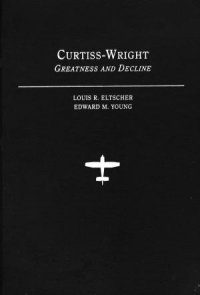 |
Curtiss-Wright
Greatness and Decline
by Lewis Eltscher and Edward Young
Hardbound, 213 pages.
Available from amazon.com
|
Reviewed by Clayton Huben
This is a good book for those who are curious as to how a major US manufacturer of
airplanes and engines during WW II came into being and then essentially
disappeared in the post war years. The book begins by telling the history of
Glen H. Curtiss and the Wright brothers and their early involvement in aviation.
During this period they were bitter rivals, and surprisingly, the Wrights became
more successful building engines and Curtiss was better known for his airplanes.
The fortunes of both companies rose with WW I and then declined as surplus
aircraft and engines flooded the market. The aviation industry again began to
flourish during the late 1920s and the two companies merged on 27 June 1929. In
1929 6,034 military and commercial aircraft were produced. In October of that
year the stock market crashed and it would be 10 years before the production
levels of 1929 would again be seen. During the intervening years prior to WW II,
Wright Aeronautical Corporation was saved from bankruptcy by its air-cooled
radial engines. WW II changed everything and Curtiss-Wright was at its peak of
power and prestige in 1943 although its management and engineering was over
extended and barely able to keep up with production let alone new development. A
series of poor management decisions following WW II led to its ultimate decline.
In the words of one former employee, "Curtiss-Wright did five billion dollars
worth of business during World War II and never recovered."
The book is primarily concerned with the business and
management aspects of the companies. Nevertheless, it does cover the products,
both engines and airplanes, in terms of their timing, problems and competitive
advantage. For example, the R-3350 played a major role in the ultimate failure
of the company. After a troubled history starting with its inception in 1936 and
the problems in the B-29 during WW II, it led to C-Ws president R.T. Hurley's
arrogant belief that it could compete with turbojets in the post war commercial
airline fleets.
There are 16 photographs and nine charts dealing primarily
with production and sales. This is a good read for anyone interested in either
Curtiss-Wright or the first half century history of the reciprocating engine in
the United States.
 |
British Light Aeroplanes
Their Evolution, Development and Perfection
1920-1940
by Arthur Ord-Hume
Hardbound, approx 8" x 10", 656 pages
1,027 photographs, 98 three-view drawings |
Reviewed by Richard Kamm
It always comes as a pleasant surprise to find a book that presents a subject
in a new and better way. Such a book is British Light Aeroplanes, Their
Evolution, Development and Perfection 1920-1940 by Arthur Ord-Hume. This
book not only covers the British light airplanes produced between 1920 and 1940,
but it also covers the light aircraft engines and small propellers produced
during that period. Chapter 7 (28 pages) is titled "The Wayward Engine -
Aviation's Weakest Link. Chapter 9 (16 pages) is titled "Chronology of British
Light Aircraft & Engines - 1920-1940". Chapter 12 (47 pages, 41 pages on engines
and 6 pages on propellers) is "British Light Aircraft Engines and Propellers
1920-1940" with individual sections for each engine and propeller manufacturer.
There is even a separate 4-page Index for Engine Manufacturers & Engines.
As you can see by
the description, there are many illustrations of aircraft and engines throughout
the book, yet this is not one of the current styles of text-less picture books.
The pictures and illustrations in the book are in support of the extensive text.
The greater part of most pages is text.
Also of interest in this book is the author's description of the
double-dealings and financial shenanigans of some of the aircraft and engine
manufacturers during that era.
It should be noted that the engine portion includes several engines, mostly
converted motorcycle engines, which I could not find in any other book
(including the 1939 Aerosphere). This is the first book I can think of that
adequately covers both the aircraft and engines of a specific era and it should
become a benchmark for future publications. Despite its cost (70 British pounds
or approximately $120 US), I highly recommend this book for anyone interested in
the development of the light airplane and its engine.
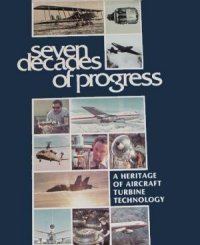 |
Seven Decades of Progress
A Heritage Of Aircraft Turbine Technology
Hardbound ,223 pages
General Electric Company,1979
ISBN 0-8168-8355-6
Aero Publishers, Inc., Fallbrook, CA
http://www.biblio.com
http://www.alibris.com
|
Reviewed by Gary Brossett
The book began as a research project in 1975, at the
request of Gerhard Neumann, a prominent figure in General Electric's history in
the 60s and 70s. It chronicles GE's Aircraft Engine Group from early
turbosuperchargers, through America's first turbojet, to modern high bypass
turbofan engines. It is packed with engine photos and biographies of
key historical figures in GE's history.
The pictorial walk through GE's engine history alone makes
the book a keeper on any turbine engine enthusiast's bookshelf. The book is
filled with pages of outstanding photos, such as the X211 nuclear engine and GE1
demonstrator. The text explains the evolution of engine lines, such as the GE1,
great grandfather of the modern F110 (F-16 fighter), F101 (B-1B bomber) and F118
(U-2 Reconnaissance aircraft) engines.
The text focuses on design, demo and production of engines
at GE. Technical specifications are limited to thrust and power ratings.
TABLE OF CONTENTS
The Prelude
The Twenties
The Thirties
The Forties
The Fifties
The Sixties
The Seventies
Engine Chronology





